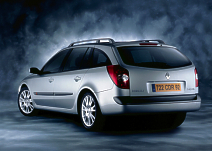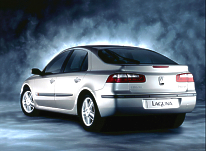
.
. .
..
. . .
Renault Concepts Renault Cars Related Topics
© 1998 - 2005 Copyright &
|
Renault : Development and Launch of the Renault Laguna II
all photos: Renault The Laguna II was entirely designed and developed at the Technocentre. It is the first project to be completely carried through at Renaultís Research and Development Centre, based at Guyancourt in the Paris region of France, which allows Renault to design better and faster, yet with less expense. By gathering together on this single site all those who contributed to the design and development of the Laguna II, as well as the design of its means of production (other than the powertrains), Renault ensured perfect synchronisation between development of the car and its means of production. The objective was to deliver to Sandouville a car with the highest level of quality, needing no subsequent work either to the car itself or its production process. Renault spent more than 5 million hours on development work as part of the initial overall layout of FRF 6 billion (EUR 914.7 million) for the Laguna replacements, representing a saving of over 30% compared with the previous generation.
1.5-year saving in development time in comparison with the Laguna The Laguna II was developed in 42 months compared with 58 months for the Laguna, cutting almost a year and a half off development times. The "project team" dedicated to the Laguna II, within the M2S programme department, installed at the Technocentre, in fact allowed perfect synchronisation between development of the product and of its processes. The Laguna II project thus brought together the expertise of all the functional units within the authority of the project team, led by Yves Dubreil, Renaultís M2S Programme Director. Researchers, designers, engineers and "product/process" development technicians, quality specialists, data processing experts, representatives of the purchasing, after-sales, training and social development functions were thus involved in the project. By bringing together these areas of expertise and skills on a single site, Renault was able to save more than FRF 1 billion (EUR 152.45 million) when compared with a project developed in several separate geographic locations. New management at the service of innovation To accelerate the integration of innovations within new vehicles designed by Renault, the M2S programme department created a new job, the Innovation Project Leader. He was entrusted with creating and deploying an innovative management process to ensure that technological innovations were integrated, within the given timeframe, in the Laguna II and other future medium and upper-range cars in the Renault range. The need for such a job became apparent with the emergence of the idea of the "system" in vehicle engineering: new technologies were no longer in effect localised within a particular vehicle function but involved several units, calling for the mobilisation and coordination of many "interfaces" between the areas of expertise of different functional groups. Each of these innovations is now managed as a sub-project, in close collaboration with the vehicle project groups. The Innovation Project Leader draws together the necessary internal and external skills and directs them so that the innovation becomes total, collective and solidly established. The aim of this is to bring innovation to market as quickly as possible, against a background of greatly increased complexity and of ever greater constraints on time and cost. Sandouville: Renaultís top-of-the-range production plant Renault will build the Laguna II in a single European factory, that of Sandouville (Normandy, France). With a total site area of 152 ha, 51 ha of which is accounted for by buildings, the body assembly plant at Sandouville has specialised, since its establishment in 1964, in the production of Renaultís top-of-the-range cars, and has produced more than 6 million units. With a workforce of over 6,000, Renault Sandouville is responsible for 10% of all Renault production (passenger cars plus light commercial vehicles). As the main employer in the region, the factory constitutes a major part of the economy of Normandy, and is notable for its network of 44 suppliers located in 4 departments of the region. More than FRF 4 billion to renew production tooling To provide for the manufacture of Renaultís future top-of-the-range models (replacements for the Safrane, Espace and Grand Espace) and cars in the upper medium segment (Laguna II and Laguna II Estate), the factory has invested FRF 4.25 billion (EUR 647,9 million) in renewing its production facilities. This reorganisation of production tooling, focussed on operations which add value for the end customer, will allow Sandouville to improve its productivity and its industrial performance to achieve, one year after the start-up of Laguna II production, a production time of 15 hours IMVP (International Motor Vehicle Program) A more flexible factory, packed with innovations The press shop has been modernised at an investment cost of FRF1.8 billion (EUR 274.5 million). It now comprises 6 press lines with robotized loading, which makes the production programme more flexible. A new installation carries out laser welding of blanks, which allows the amount of metal used to be measured more precisely. In addition, all the facilities are encapsulated by soundproofing enclosures. The B.I.W. assembly shop has been completely renewed for an investment of FRF 1.4 billion (EUR 213.4 million). With 95% automation, it houses over 400 robots which manage the different types of vehicle. Robotised assembly of exhaust systems takes place in synchronisation with final assembly. Assembly of the chassis and of the body shells takes place on a flexible line. For this purpose, pallets adapted to each type of vehicle allow the automatic stations or robots to weld the different types of body. The paint shop (FRF 550 million/EUR 83.8 million invested), extensively robotised, incorporates a new cataphoretic stage using the very latest technology which, by penetrating box sections more effectively, ensures better protection for the body against corrosion. A new facility completes the process by applying polymerised wax within box sections, preventing corrosion wherever the cataphoretic protection alone would not be sufficient. Final assembly has benefited from an investment of FRF 500 million (EUR 76.2 million). Its robots have been renewed while a variable-height trim facility (an investment of FRF 50 million) places the vehicle at the best working height for the operator. This facility carries the workers on platforms while adjusting the height of the vehicle. Apart from improving ergonomics and reducing fatigue, it improves productivity thanks to less movement, the elimination of raising and lowering of production line stations and the possibility of working on both sides of the vehicle. It allows the operator to concentrate entirely on operations which add value for the customer. Logistics have seen major changes thanks to the supplier industrial park but also within the framework of L3P: Logistique Performante Programmťe pour the Poste de travail (programmed logistics performance for the workstation). L3P supplies a sequenced flow (small batches) of parts and increases the proportion of small recoverable containers, reducing stockholding and improving the organisation of the workstations. This system thus results in the transportation of 30% less container volume for the manufacture of a Laguna II than was needed for the previous generation. A supplier park which creates diversity on the site of the factory itself Renault has opened a supplier industrial park covering 36,000m≤ and bringing together six of the main suppliers on the site of the Sandouville factory. The park houses six suppliers involved in manufacturing the Laguna II and Renaultís future top-of-the-range vehicles: Antolin (roof trim), Faurecia (seats), Inoplast (boot lids), Lear (wiring looms), Solvay (fuel tanks) and Sommer Allibert (dashboards, consoles, carpets, door panels). Eventually, 600 jobs could be created by these suppliers. Apart from strengthening links with single partners for the development and production of important vehicle functions, the park allows the suppliers to be situated closer to the assembly facility, most notably to make possible sequenced ("just in time ") deliveries. A conveyor system between the park and the assembly line places the suppliers within easy reach of the workstations and this reduces the volume of components in transit. At the logistic level, supplier industrial parks allow diversity to be managed closer to the assembly line and contribute to more secure sourcing. They present advantages in terms of cost as well as quality. The reduction in the amount of stock held at lineside together with the reduction of volumes in transit ahead of time effectively result in greater economic efficiency. In addition, direct access to the assembly line allows immediate quality checking and thus the fast and direct correction of any faults which arise, by the supplier, before the vehicle leaves the line. The Sandouville factory also houses a 7th supplier, Plastic Omnium (bumpers), directly involved in assembly. This supplier delivers to lineside, in process order, the parts which it manufactures. Connected to a data processing system, it receives messages like any other workshop forming part of the factory. Construction of the park cost FRF 80 million (EUR 12.2 million). Investment in the location was financed by Renault which benefited, to the extent of 20%, from contributions from local organisations, the region and the French state.
|
. |










